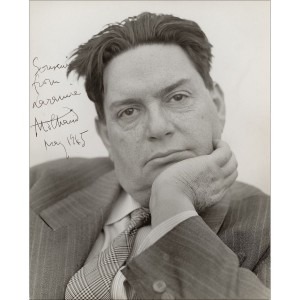 Darius Milhaud grew up in a Latin-Mediterranean cultural milieu that particularly valued Italian music. When a young man wrote to him about Wagner’s theories that all art “springs from suffering, unhappiness, and frustration,” he replied. “I am glad you decided to write me about your problem with Wagner’s theories; here is my point of view, if you want it. I had a marvelously happy childhood. My wife is my companion, my collaborator; we are the best of friends, and this gives me great happiness. My son is a painter who works incessantly, and he is sweet and loving to his parents. Thus I can say that I’ve had a happy life, and if I compose, it’s because I am in love with music and I wouldn’t know how to do anything else…Your Wagner quote proves to me once again that he was an idiot.”
Darius Milhaud grew up in a Latin-Mediterranean cultural milieu that particularly valued Italian music. When a young man wrote to him about Wagner’s theories that all art “springs from suffering, unhappiness, and frustration,” he replied. “I am glad you decided to write me about your problem with Wagner’s theories; here is my point of view, if you want it. I had a marvelously happy childhood. My wife is my companion, my collaborator; we are the best of friends, and this gives me great happiness. My son is a painter who works incessantly, and he is sweet and loving to his parents. Thus I can say that I’ve had a happy life, and if I compose, it’s because I am in love with music and I wouldn’t know how to do anything else…Your Wagner quote proves to me once again that he was an idiot.”
When Milhaud stayed in Brazil as Secretary to Paul Claudel in 1917/18, he fell in love with South American music. And during his visits to the United States he heard and adored “authentic jazz in the streets of Harlem.” Jazz, he had earlier written, “is of tremendous interest and I am fascinated and intrigued by the jazz rhythmic power that was a real shock when I heard it for the first time. Jazz is the most significant thing in music today.” In the history of music we count Milhaud among a rare group of classical composers who successfully amalgamated jazz and art music in works that integrate the American style with traditional European procedures. And that includes his 1947 concerto for marimba and vibraphone, two instruments rarely heard in symphonic orchestras. Combining two like-minded mallet instruments—the marimba is a xylophone while the vibraphone produces sounds via metal plates and resonance tubes—Milhaud discloses his preference for clear and distinct colors and sonorities. One performer, who must quickly move from one to the other to obtain the exotic contrasts the composer desired, plays both instruments. Five different types of mallets are specified to achieve varying sonorities, and a still different sonority is created by the use of the hands to strike the marimba. Relying on a traditional concerto form and structure, 2 jazzy and percussive movements frame a sidereal meditation of nocturnal beauty.
Darius Milhaud: Concerto for Marimba and Vibraphone and Orchestra (Piano)
1st Movement
Darius Milhaud: Concerto for Marimba and Vibraphone, Op. 278

Thank you for writing this. I thoroughly enjoyed your story about Vagner at the beginning. I was sad to see that the original reference for the quote was missing from the end. Any chance you know where the quote came from? As a percussionist I felt the need to point out a few things in your description of the piece. I hope that my comments below will be helpful to you.
The Marimba is NOT a xylophone. The marimba is related to the Ghanian Balafon (or Gyil). The marimba and the vibraphone are actually very similar, and your description makes them seem like chimes more than vibraphone. The marimba is wood, that resonates through pipes (Resonators) and the Vibraphone has metal keys (resonating though pipes). The keys are virtually the same, save their composite materials.
Milhaud was giving a talk at an American college in 1962 when a student approached him after the conference on the suffering of the artist. In all likelihood, that student was paraphrasing from Wagner’s “Art-Work of the Future” from 1849.”